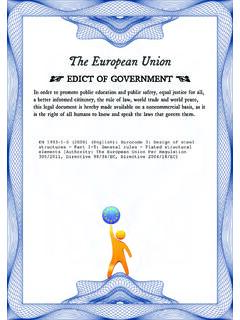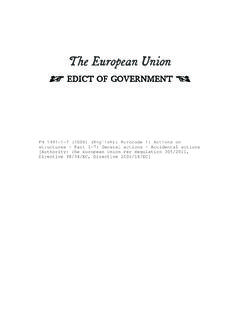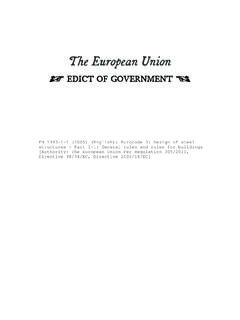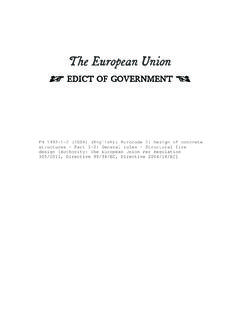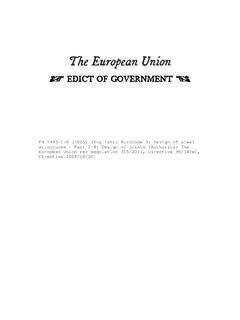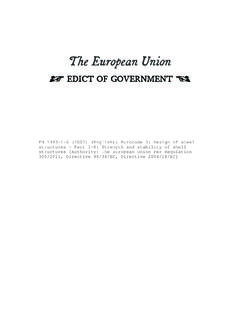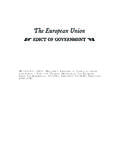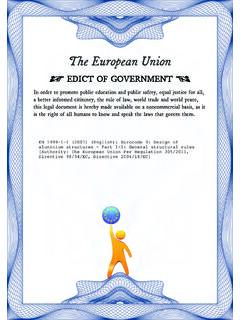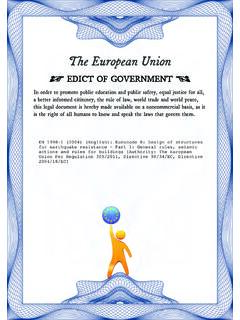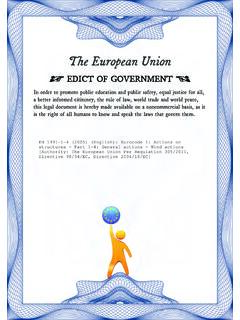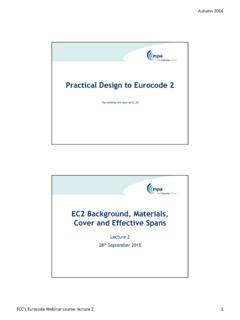Transcription of EN 1993-5: Eurocode 3: Design of steel structures - Part 5 ...
1 The European UnionIn order to promote public education and public safety, equal justice for all, a better informed citizenry, the rule of law, world trade and world peace, this legal document is hereby made available on a noncommercial basis, as it is the right of all humans to know and speak the laws that govern them. EDICT OF GOVERNMENT EN 1993-5 (2007) (English): Eurocode 3: Design of steelstructures - part 5: Piling [Authority: The European UnionPer Regulation 305/2011, Directive 98/34/EC, Directive2004/18/EC]EUROPEAN STANDARD NORME EUROPEENNE EUROP)\ISCHE NORM EN 1993-5 February 2007 ICS ; Supersedes ENV 1993-5: 1998 Incorporating corrigendum May 2009 English Version Eurocode 3 - Design of steel structures - part 5: Piling Eurocode 3 -Calcul des structures en acier - Partie 5: Pieux et palplanches Eurocode 3 -Bemessung und Konstruktion von Stahlbauten - Teil 5: Pfahle und Spundwande This European Standard was approved by CEN on 12 June 2006.
2 CEN members are bound to comply with the CEN/CENELEC Internal Regulations which stipulate the conditions for giving this European Standard the status of a national standard without any alteration. Up-to-date lists and bibliographical references concerning such national standards may be obtained on application to the CEN Management Centre or to any CEN member. This European Standard exists in three official versions (English, French, German). A version in any other language made by translation under the responsibility of a CEN member into its own language and notified to the CEN Management Centre has the same status as the official versions. CEN members are the national standards bodies of Austria, Belgium, Bulgaria, Cyprus, Czech Republic, Denmark, Estonia, Finland, France, Germany, Greece, Hungary, Iceland, Ireland, Italy, Latvia, Lithuania, Luxembourg, Malta, Netherlands, Norway, Poland, Portugal, Romania, Slovakia, Slovenia, Spain, Sweden, Switzerland and United Kingdom.
3 EUROPEAN COMMITTEE FOR 5T ANDARDIZATION COMITE EUROPEEN DE NORMALlSA TION EUROPAISCHES KOMITEE FOR NOR MUNG Management Centre: rue de Stassart, 36 B-1050 Brussels 2007 CEN All rights of exploitation in any form and by any means reserved worldwide for CEN national Members. Ref. No. EN 1993-5: 2007: E BS EN 1993-5: 2007 EN 1993-5: 2007 (E) Contents Page Foreword .. 4 1 General .. 7 Scope .. 7 Norlnative references .. 8 Assulnptions .. 8 Distinction between principles and application rules .. 9 Definitions .. 9 Sytnbols .. 9 lJnits .. 10 Ternlinology .. 11 Convention for sheet pile axes .. 19 2 Basis of desigll .. 20 General .. 20 Ultimate limit state criteria .. 20 Serviceability limit state criteria .. 21 Site investigation and soil parameters .. 21 Analysis .. 22 Design assisted by testing .. 23 Driveability .. 24 3 Material prOIJerties .. 25 3. 1 General.
4 25 Bearing piles .. 25 Hot ro]]ed steel sheet piles .. 25 Cold formed steel sheet piles .. 25 Sections used for waling and bracing .. 26 Connecting devices .. 26 steel members used for anchors .. 26 steel members used for combined walls .. 26 Fracture toughness .. 27 4 Durability .. 28 General .. 28 Durability requirements for bearing piles .. 29 Durability requirements for sheet piling .. 30 Corrosion rates for Design .. 30 5 Ultimate limit states .. 32 Basis .. 32 Sheet piling .. 32 Bearing piles .. 46 I-ligh Inodulus walls .. 48 COlnbined walls .. 49 6 Serviceability limit states .. 52 6. J Basis .. 52 Displacements of retaining walls .. 52 Displacements of bearing piles .. 52 Structural aspects of steel sheet piling .. 52 7 Anchors, walings, bracing and cOllnections .. 54 7. I General .. 54 2 BS EN 1993 .. 5:2007 EN 1993-5: 2007 (E) Anchorages.
5 54 Walings and bracing .. 56 Connections .. 56 8 Execution .. 64 General .. 64 steel sheet piling .. 64 Bearing piles .. 64 Anchorages .. 64 Walings, bracings and connections .. 64 A [normative] - Thin walled steel sheet piling .. 65 General .. 65 Basis of Design .. 66 Properties of materials and cross-sections .. 66 Local buckling .. 70 Resistance of cross-sections .. 72 Design by calculation .. 76 Design assisted by testing .. 77 B [informative] - Testing of thin walled steel sheet piles .. 79 General .. 79 Single span bealTI test .. 79 Interluediate support test .. 80 Double span beam test .. 81 Evaluation of test results .. 82 C [informative] - Guidance for the Design of steel sheet piling .. 84 C.] Design of sheet pile cross section at ultimate limit state .. 84 Serviceability lilTIit state .. 87 D [informative] - Primary elements of combined walls.
6 89 I-sections used as primary elements .. 89 Tubular piles used as primary elements .. 91 3 BS EN 1993 .. 5:2007 EN 1993 .. 5:2007 (E) Foreword This European Standard EN 1993-5, " Eurocode 3: Design of steel structures : part 5 Piling", has been prepared by Technical Committee CEN/TC250 Structural Eurocodes , the Secretariat of which is held by BSI. CEN/TC250 is responsible for all Structural Eurocodes. This European Standard shall be given the status of a National Standard, either by publication of an identical text or by endorsement, at the latest by August 2007, and conflicting National Standards shall be withdrawn at latest by 1v1arch 20 I O. This Eurocode supersedes ENV 1993-5: 1998. According to the CEN-CENELEC Internal Regulations, the National Standard Organizations of the fol1owing countries are bound to implement this European Standard: Austria, Belgium, Bulgaria, Cyprus, Czech Republic, Denmark, Estonia, Finland, Germany, Greece, Hungary, Iceland, Ireland, Italy, Latvia, Lithuania, Luxembourg,Malta, Netherlands, Norway, Poland, Portugal, Romania, Slovakia, Slovenia, Spain, Sweden, Switzerland and United Kingdom.
7 Background to the Eurocode prograrrlme In 1975, the Commission of the European Community decided on an action programme in the field of construction, based on article 95 of the Treaty. The objective of the programme was the elimination of technical obstacles to trade and the harmonisation of technical specifications. Within this action programme, the Commission took the initiative to establish a set of harmonised technical rules for the Design of construction works which, in a first would serve as an alternative to the national rules in force in the Member States and, ultimately, would replace them. For fifteen years, the Commission, with the help of a Steering Committee with Representatives of Member States, conducted the development of the Eurocodes programme, which led to the first generation of European codes in the 1980's. In 1989, the Commission and the Member States of the EU and EFTA decided, on the basis of an agreementl between the Commission and to transfer the preparation and the publication of the Eurocodes to the CEN through a series of Mandates, in order to provide them with a future status of European Standard (EN).
8 This links de facto the Eurocodes with the provisions of all the Council's Directives and/or Commission's Decisions dealing with European standards ( the Council Directive 89/1 06/EEC on construction products -CPD and Council Directives 93/37/EEC, 921S0lEEC and 89/440lEEC on public works and services and equiva1ent EFTA Directives initiated in pursuit of setting up the internal market). The Structural Eurocode programme compIises the following standards generally consisting of a number of Parts: 4 EN 1990 EN 1991 EN 1992 EN 1993 EN 1994 EN 1995 EN 1996 EN 1997 EN ]998 EN 1999 Eurocode : Basis of structural Design Eurocode 1: Actions on structures Eurocode 2: Design of concrete structures Eurocode 3: Design of steel structures Eurocode 4: Design of composite steel and concrete structures Eurocode 5: Design of timber structures Eurocode 6: Design of masonry structures Eurocode 7: Geotechnical Design Eurocode 8: Design of structures for earthquake resistance Eurocode 9: Design of aluminium structures Agreement between the Commission of the European Communities and the European Commillee for Standardisation (CEN) concerning the work on EUROCODES for the Design of and civil engineering works (BC/CENI03/89).
9 BS EN 1993-5: 2007 EN 1993-5: 2007 (E) Eurocode standards recognise the responsibility of regulatory authorities in each Member State and have safeguarded their right to determine values related to regulatory safety matters at national level vvhere these continue to vary from State to State. Status and field of application of Eurocodes The Member States of the EU and EFTA recognise that Eurocodes serve as reference documents for the following purposes: as a means to prove compliance of building and civil engineering works with the essential requirements of Council Directive 8911 06/EEC, particularly Essential Requirement N I Mechanical resistance and stability and Essential Requirement N 2 Safety in case of fire; as a basis for specifying contracts for construction works and related engineering services; as a framework for drawing up harmonised technical specifications for construction products (ENs and ETAs) The Eurocodes, as far as they concern the construction works themselves, have a direct relationship with the Interpretative Documents2 referred to in Article 12 of the CPD, although they are of a different nature from harmonised product standard3 Therefore, technical aspects aIising from the Eurocodes work need to be adequately considered by CEN Technical Committees and/or EOTA Working Groups working on product standards with a view to achieving a full compatibility of these technical specifications with the Eurocodes.
10 The Eurocode standards provide common structural Design rules for everyday use for the Design of whole structures and component products of both a traditional and an innovative nature. Unusual forms of construction or Design conditions are not specifically covered and additional expert consideration will be required by the designer in such cases. National Standards implementing Eurocodes The National Standards implementing Eurocodes will comprise the full text of the Eurocode (including any annexes), as published by CEN, which may be preceded by a National title page and National foreword, and may be followed by a National Annex (informative). The National Annex (informative) may only contain information on those parameters which are left open in the Eurocode for national choice, known as Nationally Determined Parameters, to be used for the Design of buildings and civil engineering works to be constructed in the country concerned, : values for partial factors and/or classes where alternatives are given in the Eurocode , values to be used where a symbol only is given in the Eurocode , geographical and climatic data specific to the Member State, snow map, the procedure to be used where alternative procedures are given in the Eurocode , references to non-contradictory complementary information to assist the user to apply the Eurocode .
